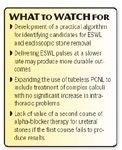Article
Stone studies advance technology in small steps
Stone disease studies being presented at the upcoming AUA annual meeting are progressing deliberately along several fronts.

Key Points

He told Urology Times that the clinical parameters determining the efficacy of extracorporeal shock wave lithotripsy are coming into tighter focus; simple measures that improve percutaneous stone removal outcomes are being evaluated; morbidity associated with percutaneous removal is being reduced; and the risk of stone disease in patients who are undergoing bariatric surgery is being more accurately identified.
"Studies are under way to better predict outcomes of shock wave lithotripsy fragmentation of renal and ureteral calculi. Parameters such as stone-to-skin distance, the body habitus or body characteristics, stone volume, and stone density measured in Hounsfield units are shown to predict SWL success," Dr. Preminger said. "As data such as this continues to grow, it will allow the development of practical algorithms that will improve the ability to identify those patients who are good candidates for SWL and those who should undergo endoscopic stone removal."
Dr. Preminger noted that the technical parameters of ESWL treatment are also becoming better understood and more refined. When the technology was initially developed, the pulse or speed at which shocks were administered was gated to heart rates out of concern that ESWL pulses might engender arrhythmia, he explained. When it was shown that this complication was not a significant problem, the pulses were increased (ungated lithotripsy) to improve the efficiency of the procedure.

The rate of obesity in America and in most Western cultures is growing at an alarming rate, and obesity is associated with a variety of metabolic problems, including stone formation. A growing number of studies indicate that ESWL therapy in the obese is more challenging and less successful, and that alternative treatments should be considered.
"These initial retrospective studies are small, and more work needs to be done, but they are moving in the right direction," Dr. Preminger said.
Bariatric surgery for obesity is a relatively new procedure that is being used with increasing frequency in the United States due to epidemic obesity, yet these procedures can profoundly affect metabolism. A large retrospective review presented at last year's AUA meeting showed that patients undergoing bariatric procedures were at increased risk of urinary stone formation. Studies at this year's meeting show an increased risk of postoperative hyperoxaluria, which, in turn, raises the risk of calcium oxalate stones.
The studies are small, and follow-up is short, but Dr. Preminger advised that these risks should be noted and should be weighed against the benefits attributed to the surgical procedure.
Honing perc techniques
Studies appearing this year demonstrate that percutaneous stone removal techniques can also be fine tuned to improve outcomes. Among these are studies showing that the intravenous administration of a nonsteroidal anti-inflammatory drug according to a rigid standard protocol appears to be as safe and effective as narcotics in reducing postoperative pain.
"The protocol produced a significant reduction in post-op pain and a reduction in the need for additional pain medication with no changes in kidney function, creatinine, or renal bleeding," Dr. Preminger said.





